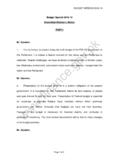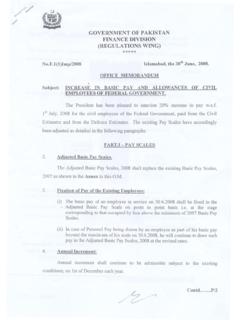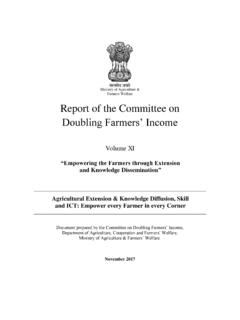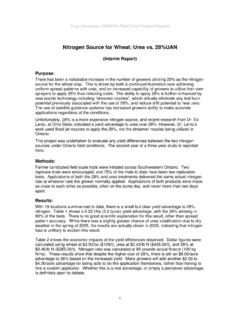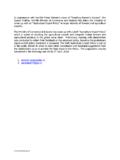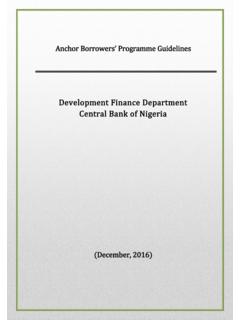Transcription of CHAPTER Agriculture - Finance
1 CHAPTER 02 Agriculture Agriculture sector is a vital component of Pakistan s economy as it provides the raw materials to down the line industries and helps in poverty alleviation. This sector contributed percent in GDP and it remains by far the largest employer absorbing percent of the country s total labour force. The Agriculture sector growth is contingent on favorable weather conditions. There is a strong relationship between Agriculture and climate temperature, precipitation, floods and other aspects of weather that finally affect economic performance including Agriculture production, commodity prices and finally economic growth. The emerging challenges of national food security and climate change have shifted the policy focus globally towards the development of Agriculture sector during past few years.
2 The high potential of this sector in earning valuable foreign exchange has been greatly realized through taping the potential in value addition sectors. Pakistan s Agriculture community consists of small farmers having various limitations in their day to day farming practices that have been translated into the fact that per yield level in Pakistan has been graded in the lower to middle ranged economy fulfilling the propensity to cater the food requirements of its growing population and with current pace of development envisages to slip to the lower ranged economies having ability to cater the nutritional needs of its population by the year 2030. The government is focusing on improving agricultural productivity by increasing crops yield, systematic application of better inputs and advance technology to enhance profitability of the farming community, improve competitiveness and ensure the environmental sustainability of Agriculture .
3 The overall objective is to achieve a sustained Agriculture growth rate of four to five percent per annum to support the overall GDP growth trajectory. To protect the farmers from the vagaries of unprecedented climate change and global slowdown in commodity prices, the government announced Kissan Package in September, 2015. Box item 1: Prime Minister s Agriculture Package of Rs 341 billion A mega relief package of Rs 341 billion has been announced by Prime Minister of Pakistan for small farmers including direct cash support and provision of soft Agriculture loans. It is aimed at introducing progressive Agriculture on scientific lines, reducing production cost of crops and make the small farmers prosperous.
4 Under the package Small farmers would get the chunk of Rs 147 billion as direct benefit while Rs 194 billion has been allocated for Agriculture loans. The farmers cultivating rice and cotton at up to acres of land would be given cash support of Rs 5,000 per acre. The government on this facility will bear the cost of Rs 20 billion each for rice and cotton crops. Announced setting up a Rs 20 billion fund to reduce prices of fertilizers which will lessen Rs 500 per bag of Potassium and Nitrate fertilizers. Also, the government was negotiating with local fertilizer manufacturers and gas companies to revert the increase in prices of fertilizers which has gone up by Rs 200 per bag. It had been decided to provide Liquefied Natural Gas (LNG) to fertilizer companies to overcome the shortages of gas supply.
5 The government would bear the Rs billion premium on the agricultural insurance which will benefit million small farmers. Solar tubewells would be provided on mark up free loans to the farmers who own up to acre of land. The Pakistan Economic Survey 2015-16 24 mark up of seven years would be paid by the federal government with a cost of Rs billion. This would ensure a saving of Rs 1,600 and Rs 500 per day for the farmers running tubewells on diesel for five hours daily and on petrol for same duration, respectively. The electricity price for running tubewells at peak hours has been fixed at Rs per unit and Rs at off-peak hours. The sales tax on these bills amounting Rs 7 billion would be borne by the federal government. The custom duty, sales tax and withholding tax on the Agriculture machinery has been reduced from 45 percent to nine percent.
6 The rice millers has been given full exemption on the turn-over tax for year 2015-16. The traders of Agriculture commodities, fruits, vegetables and fish would get an exemption of three years on income tax while the sales tax on cold chain machinery has been reduced from 17 to seven percent. The installation of production unit of Halal meat that will be registered before December 31, 2016 will be given a four-year exemption on income tax. The government would provide Rs 30 billion as the fifty percent guarantee to banks on loans. This will benefit around million farmer households through Rs million each with collateral loans. The time-limit to pay back Rs 34 billion outstanding loan on the rice traders has been extended up to June 30, 2016. The government and the State Bank of Pakistan are working over reducing the mark-up rate on Agriculture loans by two percent which would give a benefit of Rs 11 billion per annum to farmers.
7 The Zarai Taraqiati Bank Limited and commercial banks would provide one-window facility to the farmers seeking loans. The value of production unit has been increased from Rs 2,000 to Rs 4,000 which would help farmers get doubled the amount of loan against their land value. A committee under supervision of Federal Minister for National Food Security & Research has been set up which would workout the ways to increase per acre yield and reduction of Agriculture inputs. Source: Press Release by Prime Minister s Secretariat Performance during 2015-16 During FY 2016, the performance of Agriculture sector as a whole remained dismal as it witnessed a negative growth of percent against percent growth during the same period last year.
8 The growth of crops declined by percent, while the other sub component of Agriculture sector like Livestock, Forestry and Fishing posted positive growth of percent, percent and percent, respectively. The growth of sub Sector of crops included important crops, other crops and cotton ginning remained negative as it posted a growth of percent, percent and percent which impacted negatively on crops as a result became the reason of negative growth of Agriculture sector. The last negative growth in Agriculture was witnessed in 2000-01, when Agriculture growth declined to percent. Important crops having a share of percent in agricultural value added has witnessed negative growth of percent on account of large decline in cotton production ( percent), rice production ( percent) and maize production ( percent) during 2015-16 against negative growth of percent during the same period of last year.
9 While only wheat and sugarcane production witnessed a positive growth of percent and percent respectively, as compared to last year. Other crops contributed percent in value addition of Agriculture witnessed a decline of percent during 2015-16 against positive growth of percent during the same period last year due to decline in the production of pulses, fruits and oilseeds posting negative growth of percent, percent and percent, respectively. With drop in cotton production by around percent this year the Cotton ginning having a share of percent in value addition of Agriculture has suffered badly and posted a negative growth of Agriculture 25 percent compared to percent growth during the same period last year.
10 The Livestock sector having contribution of percent in the Agriculture recorded a positive growth of percent during 2015-16 compared to percent growth during the same period last year. The Fishing sector having contribution of percent in Agriculture value addition recorded a growth of percent compared to percent growth of last year. Forestry sector having contribution of in the Agriculture value addition posted a growth of percent this year as compared to the negative growth of percent last year. (Table ) Table : Agriculture growth percentages (Base=2005-06) Sector 2009-10 2010-11 2011-12 2012-13 2013-14 2014-15 2015-16(P) Agriculture Crops i) Important Crops ii) Other Crops iii) Cotton Ginning Livestock Forestry Fishing Source: Pakistan Bureau of Statistics P: Provisional Pakistan has two crop seasons, "Kharif" being the first sowing season starting from April-June and is harvested during October-December.
